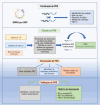Polygenic Risk Scores: The Next Step for Improved Risk Stratification in Coronary Artery Disease?
- PMID: 39352188
- PMCID: PMC11495647
- DOI: 10.36660/abc.20240252
Polygenic Risk Scores: The Next Step for Improved Risk Stratification in Coronary Artery Disease?
Abstract
Despite significant advances in the management of coronary artery disease (CAD) and reductions in annual mortality rates in recent decades, this disease remains the leading cause of death worldwide. Consequently, there is an ongoing need for efforts to address this situation. Current clinical algorithms to identify at-risk patients are particularly inaccurate in moderate-risk individuals. For this reason, the need for ancillary tests has been suggested, including predictive genetic screening. As genetic studies rapidly expand and genomic data becomes more accessible, numerous genetic risk scores have been proposed to identify and evaluate an individual's susceptibility to developing diseases, including CAD. The field of genetics has indeed made substantial contributions to risk prediction, particularly in cases where children have parents with premature CAD, resulting in an increased risk of up to 75%. The polygenic risk scores (PRSs) have emerged as a potentially valuable tool for understanding and stratifying an individual's genetic risk. The PRS is calculated as a weighted sum of single-nucleotide variants present throughout the human genome, identifiable through genome-wide association studies, and associated with various cardiometabolic diseases. The use of PRSs holds promise, as it enables the development of personalized strategies for preventing or diagnosing specific pathologies early. Furthermore, it can complement existing clinical scores, increasing the accuracy of individual risk prediction. Consequently, the application of PRSs has the potential to impact the costs and adverse outcomes associated with CAD positively. This narrative review provides an overview of the role of PRSs in the context of CAD.
Apesar dos avanços significativos no tratamento da doença arterial coronariana (DAC) e das reduções nas taxas de mortalidade anuais nas últimas décadas, a DAC continua sendo a principal causa de morte no mundo. Consequentemente, há uma necessidade contínua de esforços para abordar essa situação. Os algoritmos clínicos atuais para identificar pacientes em risco são particularmente imprecisos para indivíduos de risco moderado. Por esse motivo, foi sugerido que são necessários testes auxiliares, incluindo triagem genética preditiva. À medida que os estudos genéticos se expandem rapidamente e os dados genômicos se tornam mais acessíveis, diversos escores de risco genético têm sido propostos para identificar e avaliar a suscetibilidade de um indivíduo ao desenvolvimento de doenças, incluindo a DAC. De fato, o campo da genética tem contribuído substancialmente para a previsão de risco, particularmente nos casos em que as crianças têm genitores com DAC prematura, resultando em um risco aumentado de até 75%. Os escores de risco poligênico (PRSs, do inglês polygenic risk scores) surgiram como uma ferramenta potencialmente valiosa para compreender e estratificar o risco genético de um indivíduo. O PRS é calculado como uma soma ponderada de variantes de nucleotídeo único presentes em todo o genoma humano, identificáveis por meio de estudos de associação genômica ampla, e associadas a várias doenças cardiometabólicas. O uso dos PRSs é promissor, pois permite o desenvolvimento de estratégias personalizadas para prevenir ou diagnosticar patologias específicas de forma precoce. Ademais, seu uso é capaz de complementar os escores clínicos existentes, aumentando a precisão da previsão de risco individual. Consequentemente, a aplicação dos PRSs tem o potencial de impactar positivamente os custos e os desfechos adversos associados à DAC. A presente revisão narrativa oferece uma visão ampla do papel dos PRSs no contexto da DAC.
Conflict of interest statement
Figures




Similar articles
-
Precision Medicine in Cardiovascular Disease Prevention: Clinical Validation of Multi-Ancestry Polygenic Risk Scores in a U.S. Cohort.Nutrients. 2025 Mar 6;17(5):926. doi: 10.3390/nu17050926. Nutrients. 2025. PMID: 40077796 Free PMC article.
-
Polygenic Risk Scores in Predicting Coronary Artery Disease in Symptomatic Patients. A Validation Study.J Atheroscler Thromb. 2024 Jul 1;31(7):1058-1071. doi: 10.5551/jat.64623. Epub 2024 Feb 23. J Atheroscler Thromb. 2024. PMID: 38403640 Free PMC article.
-
Enhancing prediction accuracy of coronary artery disease through machine learning-driven genomic variant selection.J Transl Med. 2024 Apr 16;22(1):356. doi: 10.1186/s12967-024-05090-1. J Transl Med. 2024. PMID: 38627847 Free PMC article.
-
Polygenic risk scores in coronary artery disease.Curr Opin Cardiol. 2019 Jul;34(4):435-440. doi: 10.1097/HCO.0000000000000629. Curr Opin Cardiol. 2019. PMID: 30994529 Review.
-
Polygenic Risk Scores and Genetically Complex Eye Disease.Annu Rev Vis Sci. 2024 Sep;10(1):403-423. doi: 10.1146/annurev-vision-102122-103958. Epub 2024 Sep 2. Annu Rev Vis Sci. 2024. PMID: 38648289 Review.
Cited by
-
Familial Combined Hyperlipidemia: Myth or Reality?Curr Atheroscler Rep. 2025 Apr 1;27(1):45. doi: 10.1007/s11883-025-01289-9. Curr Atheroscler Rep. 2025. PMID: 40167575 Free PMC article. Review.
References
-
- Akintoye E, Afonso L, Jayanna MB, Bao W, Briasoulis A, Robinson J. Prognostic Utility of Risk Enhancers and Coronary Artery Calcium Score Recommended in the 2018 ACC/AHA Multisociety Cholesterol Treatment Guidelines Over the Pooled Cohort Equation: Insights from 3 Large Prospective Cohorts. J Am Heart Assoc. 2021;10(12):e019589. doi: 10.1161/JAHA.120.019589. - DOI - PMC - PubMed
Publication types
MeSH terms
LinkOut - more resources
Full Text Sources
Medical
Research Materials
Miscellaneous

